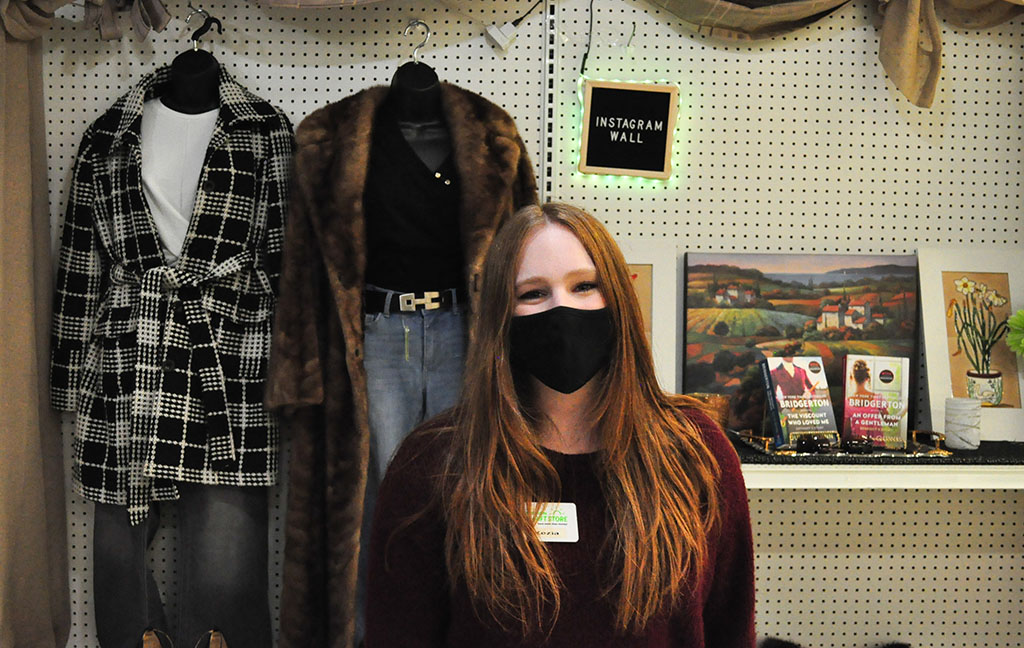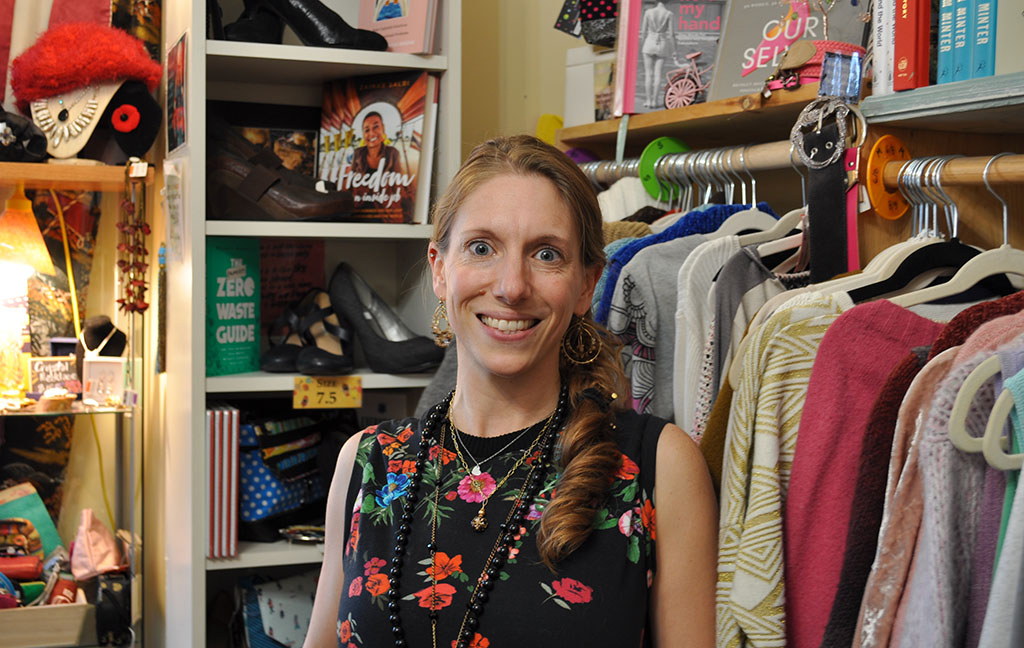
Are trendy thrifters a cause for concern or the future of fashion?
Kenzia Loucks, 17, stands in front of the Instagram wall that features the Mission Thrift Store in Orleans’s trendiest items. Loucks manages the Instagram account and social media for the Orleans store. Photo by Joy SpearChief-Morris.
When Taniel Campbell, 21, needs to decompress or find a bit of time for herself, she can be found getting lost among the aisles of clothes thrifting at the South Keys’ Value Village.
Campbell, a Carleton University student, discovered her love for thrifting two years ago after seeing curated thrift-store clothing was trending among Instagram influencers. Since moving to Ottawa this past May, she has become hooked on the fun.
According to the thredUP 2021 Resale Report, 33 million Americans bought second-hand for the first time in 2020 and 53 per cent of millennials and Gen Z shoppers said they expect to spend more on second-hand clothing within the next five years. The online second-hand retailer was launched in the United States in 2009 and since 2017 has released annual reports that track retail and consumer data.
Thrift Stores like Value Village and Mission Thrift Store have gained popularity as thrifting has become trendy among Gen Z and millennials concerned about shopping more environmentally sustainably on a budget. Yet, as thrifting becomes trendier, there is a debate among both shoppers and thrift shop managers over the impact this trend will have on low-income communities who rely on their local thrift store.
When Macklemore and Ryan Lewis’ “Thrift Shop” topped the Billboard charts in 2012, stealing your “grandpa’s style” suddenly became a popular trend with millennials, with the National Association of Resale Professionals reporting a spike in sales within the resale industry.
“You had to go to the thrift store and find some sort of crazy looking sweater to kind of pull off that look, and I just remember going with that goal, and finding a bunch of really awesome pieces that I still have a couple today,” Amy Benzie, 22, said. She recalls getting into thrifting when she was in grade nine in 2014, back when grandpa sweaters were a trending style with her peers.
The quality of clothing found at thrift stores has kept Benzie, a former graphic designer based in Lethbridge, Alta., thrifting for the last seven years.
“I find that it’s just better quality and cooler designs than what’s in stores. You can find some real hidden gems that no one else has and [it’s] better for the planet,” she said.
Campbell enjoys thrift shopping for the price value as well as the quality of clothing, which she finds lasts longer than anything else she could find in a regular store.
Racking up the prices and the problems
According to thredUP’s report, second-hand fashion is expected to double fast fashion by the year 2030. Yet, this boom in second-hand fashion is worrying some experts about the affect it might have on low-income communities.
An article written by the Berkeley Economic Review found that, “the rising popularity of thrifting among more wealthy consumers,” such as younger generations or those living in more affluent communities, “reduces the already limited options available to low-income communities.”
Campbell, who is originally from Jamaica, thinks there might still be a taboo surrounding thrifting in some communities of colour, mentioning that she does not tell her mom that she thrifts and none of her friends who are people of colour are thrifters.
“It’s coming out of a poverty mindset,” she said. “You’re like, ‘Oh, why would I go back there?’ Because this thing is something that people with nothing… that’s what they do. So why are you doing that?”
Although Benzie understands that the gentrification of thrift stores is keeping clothing out of landfills by fast fashion shoppers, she worries about the consequences.
“Obviously, it’s taken a huge boom, like people with carts full of clothes, and it’s just kind of wasteful at some point, in my opinion,” she said. “But at what point are we racking up the prices, because people that don’t necessarily need to be getting cheaper clothes are thrifting.”
Benzie has noticed rising prices at Value Village. “With the boom in Tik Tok thrift shopping, everyone wants to do it. Value Village has increased their prices incredibly,” she said, preferring to shop more at Mission Thrift Store.

Jessica Vaillancourt, 36, is the owner of Bee You Creative Styles, a thrift store located in Carp, Ont. Vaillancourt sources 70 per cent of her inventory through consignment with existing clientele and the other 30 per cent through thrift stores like Value Village. In the last year, she has noticed a two to three times price increase, as well as changes to their retail strategy.
“The fact that they’ve taken away any of their regular sales, the fact that they have a rewards program that really isn’t a rewards program. Like, I could go on,” she said. “They’ve taken out all the change rooms. Obviously, that’s not necessary, but I feel they’re making more money that way.”
John Garfield Knight Jr., manager of the Mission Thrift Store in Orleans, Ont., said their store has recently dropped the prices on their clothing by five per cent.
“We are a thrift store, we are a non-profit, and the money we do generate goes elsewhere, Garfield Knight Jr. said. “But the same token, we don’t want to price ourselves to a point where only certain people can come, we want everybody.”
Despite these concerns, many thrift stores are welcoming younger shoppers with hopes of changing their perspectives on thrifting and second-hand clothes.
‘It’s no longer where everything is just thrown together all willy-nilly’
Since reopening after the provincial COVID-19 lockdowns, the Orleans Mission Thrift Store has been trying to engage with its new younger clientele.
Kenzia Loucks, 17, is a part-time staff and avid thrifter at the Orleans store but began as a volunteer the last two summers. Loucks started an Instagram account for the store to target younger shoppers on social media. She said she wanted to “show more of a fun side to the store.”
The Orleans store’s Instagram account currently has 105 followers, 60 per cent of which are females between the ages of 18 and 39.
Loucks has created an Instagram wall to display items she thinks will attract an audience online. “I’ll do clothes ensembles. Recently I’ve gotten into recreating celebrity photos, which has been fun,” Loucks said.
In Carp, Vaillancourt is also trying to change people’s perspectives on second-hand clothing through the way she curates her shop.
To walk up the stairs into Bee You Creative Styles is to walk into a thrift lover’s dream. Each room is carefully arranged to reflect the diversity of Vaillancourt’s shoppers. It aims to offer a little something for everyone, mixing vintage and designer finds with locally made items, books on sustainable fashion and those bang for your buck items.
“I think in this setting where it’s all second-hand, and from all different eras and styles, it’s an opportunity to get people excited about buying second-hand, and it’s no longer where everything is just thrown together all willy-nilly at the thrift store,” Vaillancourt said.
Garfield Knight Jr. is excited about how many younger people are coming to the store as both shoppers and resellers and believes the new trendiness of thrifting is benefitting the local community overall.
“Our mission here is to make money to better the world, and if I make $5 and a young person walks in here, who knows more about it and makes $25, my hope is they take that $25 and they buy other thrifting stuff,” he said. “So just continuously keeps more and more stuff out of the landfill.”
The focus of Vaillancourt’s business is full circle. Clothing she does not manage to sell, she donates to Savvy Seconds, a charity owned by Vera Jones in Kilburn, Ont. Savvy Seconds gives away clothing to those in need, including people escaping situations domestic violence, suffering from economic stresses or from disasters like tornadoes or fires.

Photo by Joy SpearChief-Morris.
Shopping at thrift stores out of necessity as a child with his mother is what first made Kamal Ismail, 21, a thrift shopper.
“We didn’t have a lot of money so, we would do a lot of shopping at places like Value Village,” said Ismail, who is originally from Oshawa, Ont. but lives and attends university in Toronto. “I found a lot of good things, like pretty expensive things, that were cheap.”
Ismail, who got his girlfriend into thrift shopping, was not surprised by the new trendiness of thrifting but has noticed that the activity has become a luxury for some younger shoppers. He wants these shoppers to be respectful of thrift stores and also encourages donating and keeping thrifting full circle.
“You never know what will catch someone’s eye.”





